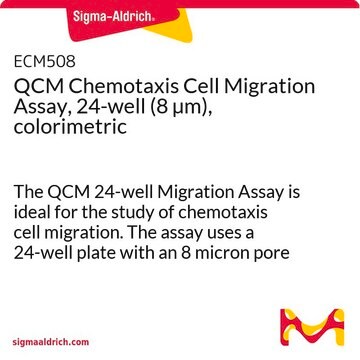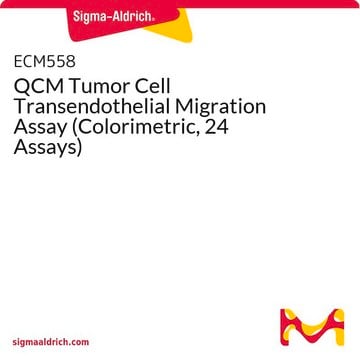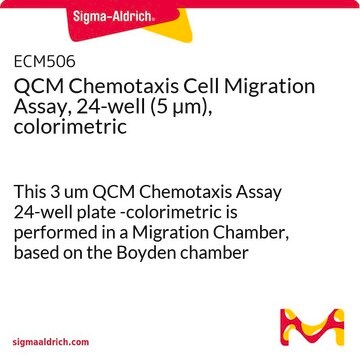ECM554
QCM ECMatrix Cell Invasion Assay, 24-well (8 µm), fluorimetric
The Cell Invasion Assay Kit kuses a 24 well plate with 8 um pores, which is ideal for evaluation of invasive tumor cells.
동의어(들):
Cell invasion assessment kit
로그인조직 및 계약 가격 보기
모든 사진(1)
About This Item
UNSPSC 코드:
12352207
eCl@ss:
32161000
NACRES:
NA.84
가격 및 재고 정보를 현재 이용할 수 없음 고객지원팀으로 연락바랍니다.
추천 제품
Quality Level
종 반응성
vertebrates
제조업체/상표
Chemicon®
QCM
기술
cell based assay: suitable
검출 방법
fluorometric
배송 상태
wet ice
애플리케이션
Research Category
Cell Structure
Cell Structure
The CHEMICON® Cell Invasion Assay Kit is ideal for evaluation of invasive tumor cells. Each CHEMICON Cell Invasion Assay Kit contains sufficient reagents for the evaluation of 24 samples. The quantitative nature of this assay is especially useful for screening of pharmacological agents.
The CHEMICON Cell Invasion Assay Kit is intended for research use only; not for diagnostic or therapeutic applications.
The CHEMICON Cell Invasion Assay Kit is intended for research use only; not for diagnostic or therapeutic applications.
The Cell Invasion Assay Kit kuses a 24 well plate with 8 um pores, which is ideal for evaluation of invasive tumor cells.
포장
24 assays
성분
Sterile 24-well Cell Invasion Plate Assembly: (Part No. 70019) Two 24-well plates with 12 ECMatrixTM-coated inserts per plate (24 coated inserts total/kit for 24 assays).
Cell Detachment Solution: (Part Number 90131) One bottle - 16 mL.
4X Cell Lysis Buffer: (Part Number 90130) One bottle - 16 mL.
CyQuant GR Dye 1: (Part Number 90132) One vial - 75 mL
Forceps: (Part Number 10203) One each.
Cell Detachment Solution: (Part Number 90131) One bottle - 16 mL.
4X Cell Lysis Buffer: (Part Number 90130) One bottle - 16 mL.
CyQuant GR Dye 1: (Part Number 90132) One vial - 75 mL
Forceps: (Part Number 10203) One each.
저장 및 안정성
Store kit materials at 2-8°C for up to their expiration date. Do not freeze.
법적 정보
CHEMICON is a registered trademark of Merck KGaA, Darmstadt, Germany
면책조항
Unless otherwise stated in our catalog or other company documentation accompanying the product(s), our products are intended for research use only and are not to be used for any other purpose, which includes but is not limited to, unauthorized commercial uses, in vitro diagnostic uses, ex vivo or in vivo therapeutic uses or any type of consumption or application to humans or animals.
신호어
Danger
유해 및 위험 성명서
Hazard Classifications
Aquatic Acute 1 - Aquatic Chronic 2 - Eye Dam. 1
Storage Class Code
10 - Combustible liquids
WGK
WGK 2
시험 성적서(COA)
제품의 로트/배치 번호를 입력하여 시험 성적서(COA)을 검색하십시오. 로트 및 배치 번호는 제품 라벨에 있는 ‘로트’ 또는 ‘배치’라는 용어 뒤에서 찾을 수 있습니다.
Bei Wang et al.
Journal of hepatology, 50(3), 528-537 (2009-01-22)
Hepatocellular carcinoma (HCC) is one of the leading causes of cancer-related death worldwide with poor prognosis associated with tumor invasion and metastasis. The tumor suppressor p53 plays critical roles in tumor development, but there is increasing evidence for its involvement
Kate Lawrenson et al.
Carcinogenesis, 32(10), 1540-1549 (2011-08-24)
The biology underlying early-stage epithelial ovarian cancer (EOC) development is poorly understood. Identifying biomarkers associated with early-stage disease could have a significant impact on reducing mortality. Here, we describe establishment of a three-dimensional (3D) in vitro genetic model of EOC
Roberta M Moretti et al.
International journal of oncology, 33(2), 405-413 (2008-07-19)
Cutaneous melanoma represents the leading cause of skin cancer deaths. The prognosis of highly aggressive, metastatic melanoma is still very poor, due to the resistance of the disseminated tumor to existing therapies. The clarification of the molecular mechanisms regulating melanoma
Xujun He et al.
Oncotarget, 8(1), 1247-1261 (2016-12-03)
Increased expression of HOXB7 has been reported to correlate with the progression in many cancers. However, the specific mechanism by which it promotes the evolution of gastric cancer (GC) is poorly understood.In this study, we sought to investigate the role
Sarah M Peterson et al.
BMC cancer, 10, 427-427 (2010-08-17)
Extracellular human sulfatases modulate growth factor signaling by alteration of the heparin/heparan sulfate proteoglycan (HSPG) 6-O-sulfation state. HSPGs bind to numerous growth factor ligands including fibroblast growth factors (FGF), epidermal growth factors (EGF), and vascular endothelial growth factors (VEGF), and
활성 필터
자사의 과학자팀은 생명 과학, 재료 과학, 화학 합성, 크로마토그래피, 분석 및 기타 많은 영역을 포함한 모든 과학 분야에 경험이 있습니다..
고객지원팀으로 연락바랍니다.










